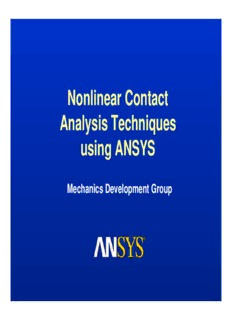
Nonlinear Contact Analysis Techniques using ANSYS - ansys.net PDF
Preview Nonlinear Contact Analysis Techniques using ANSYS - ansys.net
Nonlinear Contact Analysis Techniques using ANSYS Mechanics Development Group Outline of Presentation • General considerations • Contact applications • Contact kinematics • Node-to-node element CONTA178 • Node-to-surface element CONTA175 • Surface-to-surface elements CONTA171-174 • Multi-physics contact • Bolt Pretension Element PRETS179 • Troubleshooting • Conclusions • Future developments General Considerations in Contact Analysis • The general goal for contact analysis is to determine – Contact stresses transmitted across contacting interface – Contacting area • Contact problems present significant difficulties – Unknown contacting zone prior to the analysis – Contact constraint is either active or inactive – Friction introduces another kind of nonlinearities • A small amount of positive or negative relative sliding can change the sign of frictional forces/stresses completely. General Considerations in Contact Analysis • Contact finite element development covers – Kinematics, discretization, Inequality – Accuracy, robustness and computational overhead • The numerical treatment of contact problems involves – Formulation of geometry – Integration of interface laws – Variational formulation – Development of algorithms Contact Kinematics • Contact problem involves a variety of geometric and kinematic situations • Contact surface discretization – Contact surface must be discretized because the underlying bodies are discretized. – Node-node, node-surface, surface-surface – Smoothing provides a significant improvement in convergence behavior. • Contact detection and searching – Global search, local search • Penetration/gap calculation – Numerical iterations for higher order General Considerations • The resulting elements should be able to – Pass patch test • Mesh discretization effects – Satisfy Ladyshenskaja-Babuska-Brezzi (LBB) condition • Overconstraint criterion – Support contact with quadratic order element – Solve multi-field contact problems Uniform pressure undeformed deformed Constant pressure over one face fails LBB Solving Larger Assembly Models • In the early days of FE technology only the separate structural components of a structure were analyzed. • It is now recognized that the interaction between structural parts can have a great influence on the results. • Increased computer performance in combination with efficient solver technology and parallel computing techniques has resulted in FE models which may exceed 1,000,000 elements not only for linear but also for nonlinear analysis. Contact Applications • Boundary value problems involving contact are of great important in industrial applications in mechanical and civil engineering. The application range includes: – Metal forming, drilling problems, bearings, crash analysis, robber seal, car tires, cooling of electronic devices – Biomechanics where human joints, implants or teeth are of consideration. Application: 2D Gear Model Application: Wiring
Description: